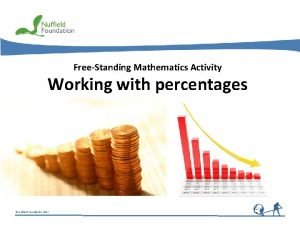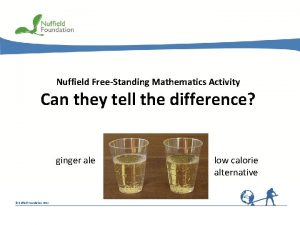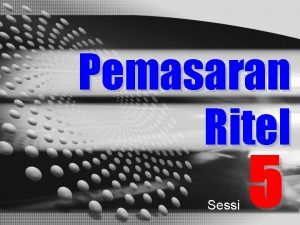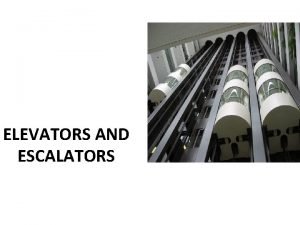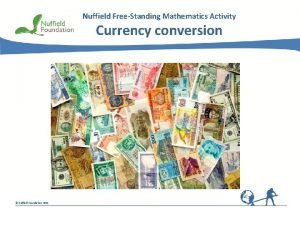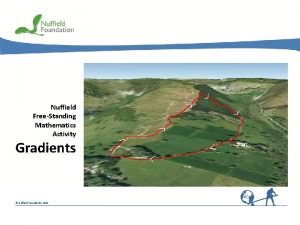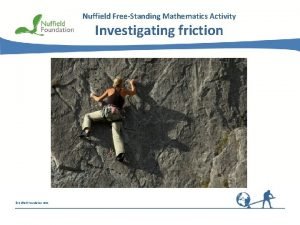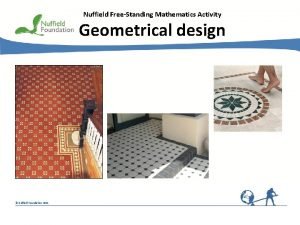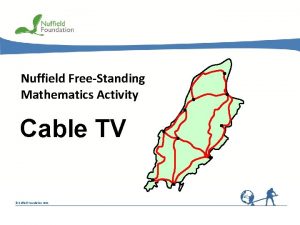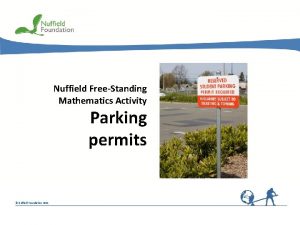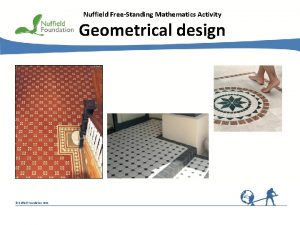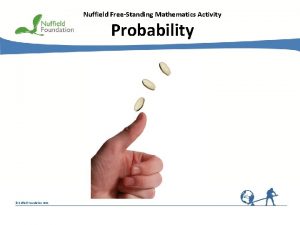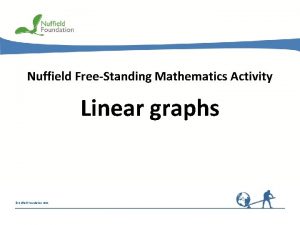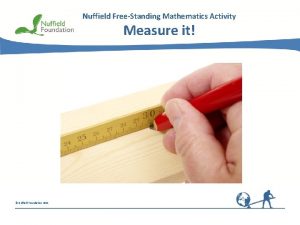FreeStanding Mathematics Activity Working with percentages Nuffield Foundation












- Slides: 12

Free-Standing Mathematics Activity Working with percentages © Nuffield Foundation 2012

A Compound interest Amount invested = £ 3000 Interest rate = 4% 1 Step-by-step method Interest at end of Year 1 = 4% of £ 3000 Think about Is the answer the same if you divide by 100, then multiply by 4? = 0. 04 x £ 3000 = £ 120 Amount at end of Year 1 = £ 3120 Interest at end of Year 2 = 4% of £ 3120 = 0. 04 x £ 3120 = £ 124. 80 Amount at end of Year 2 = £ 3120 + £ 124. 80 = £ 3244. 80 © Nuffield Foundation 2012 and so on

A Compound interest Amount invested = £ 3000 Interest rate = 4% 2 Repeating calculations using a multiplier Amount at end of Year 1 = 104% of £ 3000 = 1. 04 x £ 3000 = £ 3120 Amount at end of Year 2 = 1. 04 x £ 3120 = £ 3244. 80 and so on Try repeated calculations like this one on your calculator © Nuffield Foundation 2012

A Compound interest £ 3000 invested at 4% interest Repeated calculations How much is in the account after 5 years? End of year n Amount £ A 0 3000. 00 1 3120. 00 2 3244. 80 3 3374. 59 4 3509. 58 5 3649. 96 © Nuffield Foundation 2012

A Compound interest Amount invested = £ 3000 Interest rate = 4% 3 Using indices Amount at end of Year n = 1. 04 n x £ 3000 Amount at end of Year 2 = 1. 042 x £ 3000 = £ 3244. 80 Amount at end of Year 5 = 1. 045 x £ 3000 = £ 3649. 96 Try this A An account gives 3% interest per annum. £ 5000 is invested. How much will be in the account after 6 years? Use each method. Think about What are the advantages and disadvantages of each method? © Nuffield Foundation 2012

B Depreciation A new car costs £ 16 000. Its value falls by 15% per year What will it be worth when it is 5 years old? In this case the multiplier is 0. 85 Age of car (n years) Value (£ A) 0 16 000 1 13 600 2 11 560 3 9826 4 8352 5 7099 © Nuffield Foundation 2012 What will the car be worth when it is 20 years old? Think about What assumption is being made? Is it realistic?

B Falling sales Try this B A company’s sales of a product are falling by 6% per annum. They sold 45 000 this year. Estimate the annual sales 6 years from now. In this case the multiplier is 0. 94 Formula for annual sales n years from now = 0. 94 n x 45 000 Estimate of annual sales 6 years from now = 0. 946 x 45 000 about 31 000 Check this by repeated calculations. © Nuffield Foundation 2012

C Combining percentage changes A shareholder owns 2000 shares. She expects to get 3% more shares then plans to sell 25% of her shareholding. How many shares will she have after these transactions? Number after receiving 3% extra = 103% of 2000 = 1. 03 x 2000 = 2060 Number after selling 25% = 75% of 2060 = 0. 75 x 2060 = 1545 What % is this of her original shareholding? 1545 100 = 77. 25% or 1. 03 x 0. 75 = 0. 7725 2000 © Nuffield Foundation 2012

C Combining percentage changes Try this C A shop marks up the goods it sells by 30% In a sale it reduces its normal prices by 25% What is the overall % profit or loss on goods sold in the sale? Sale price = 75% of normal price = 75% of 130% of cost price = 0. 75 x 1. 3 x cost price = 0. 975 of cost price The shop makes a 2. 5% loss on goods it sells in the sale. © Nuffield Foundation 2012

D Reversing percentage changes The price of a train fare increased by 2. 5% recently. It now costs £ 66. 42 How much did it cost before the rise in price? 1. 025 x previous price = £ 66. 42 Previous price = £ 66. 42 1. 025 Previous price © Nuffield Foundation 2012 = £ 64. 80

D Reversing percentage changes Try this D After a 12. 5% discount, insurance costs £ 25. 90 What was the cost before the discount? 0. 875 x full price = £ 25. 90 Full price = £ 25. 90 0. 875 Full price = £ 29. 60 © Nuffield Foundation 2012

Reflect on your work • Which of the methods do you think is most efficient? • How can a graphic calculator or spreadsheet help? © Nuffield Foundation 2012
 Nuffield free-standing mathematics activity
Nuffield free-standing mathematics activity Nuffield free-standing mathematics activity
Nuffield free-standing mathematics activity Retail location adalah
Retail location adalah Freestanding freight elevator
Freestanding freight elevator Nuffield research placement
Nuffield research placement Nuffield early language intervention programme
Nuffield early language intervention programme Nuffield design and technology
Nuffield design and technology Nuffield vowels
Nuffield vowels Smart work vs hard work
Smart work vs hard work Cold working and hot working
Cold working and hot working Hot working and cold working difference
Hot working and cold working difference Differentiate between hot working and cold working
Differentiate between hot working and cold working Prinsip dasar proses pengerjaan panas yang benar adalah
Prinsip dasar proses pengerjaan panas yang benar adalah
